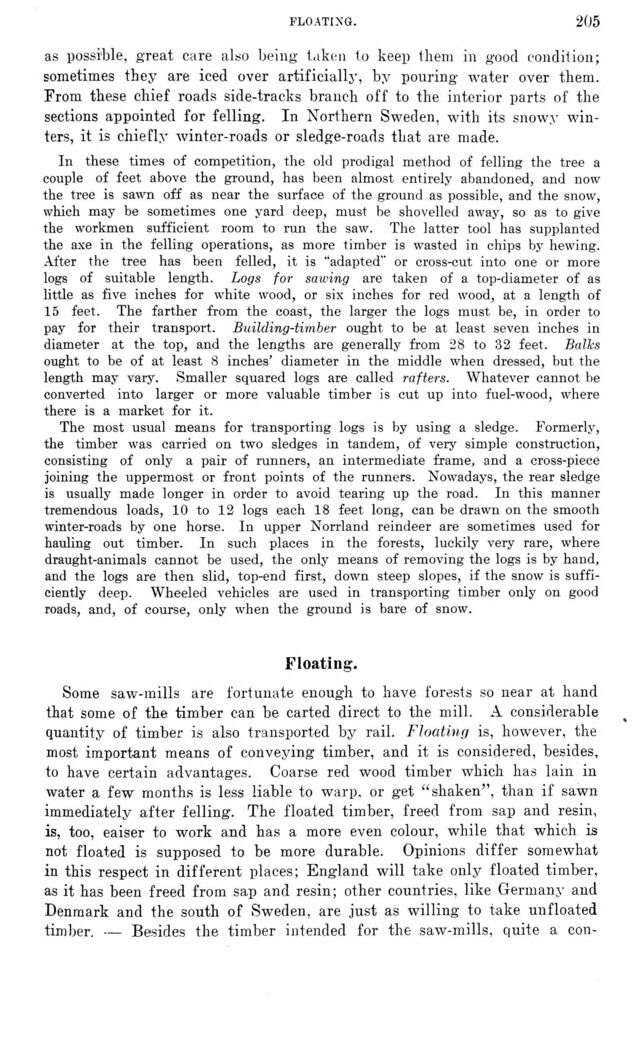
Full resolution (JPEG) - On this page / på denna sida - IV. Forestry - 2. Forest Industries. By E. Arosenius - Floating. By Th. Örtenblad

<< prev. page << föreg. sida << >> nästa sida >> next page >>
Below is the raw OCR text
from the above scanned image.
Do you see an error? Proofread the page now!
Här nedan syns maskintolkade texten från faksimilbilden ovan.
Ser du något fel? Korrekturläs sidan nu!
This page has never been proofread. / Denna sida har aldrig korrekturlästs.
FLOATING.
205
as possible, great care also being taken to keep tliem in good condition;
sometimes they are iced over artificially, by pouring water over them.
From these chief roads side-tracks branch off to the interior parts of the
sections appointed for felling. In Northern Sweden, with its snowy
winters, it is chiefly winter-roads or sledge-roads that are made.
In these times of competition, the old prodigal method of felling the tree a
couple of feet above the ground, has been almost entirely abandoned, and now
the tree is sawn off as near the surface of the ground as possible, and the snow,
which may be sometimes one yard deep, must be shovelled away, so as to give
the workmen sufficient room to run the saw. The latter tool has supplanted
the axe in the felling operations, as more timber is wasted in chips by hewing.
After the tree has been felled, it is "adapted" or cross-cut into one or more
logs of suitable length. Logs for sawing are taken of a top-diameter of as
little as five inches for white wood, or six inches for red wood, at a length of
15 feet. The farther from the coast, the larger the logs must be, in order to
pay for their transport. Building-timber ought to be at least seven inches in
diameter at the top, and the lengths are generally from 28 to 32 feet. Balks
ought to be of at least 8 inches’ diameter in the middle when dressed, but the
length may vary. Smaller squared logs are called rafters. Whatever cannot be
converted into larger or more valuable timber is cut up into fuel-wood, where
there is a market for it.
The most usual means for transporting logs is by using a sledge. Formerly,
the timber was carried on two sledges in tandem, of very simple construction,
consisting of only a pair of runners, an intermediate frame, and a cross-piece
joining the uppermost or front points of the runners. Nowadays, the rear sledge
is usually made longer in order to avoid tearing up the road. In this manner
tremendous loads, 10 to 12 logs each 18 feet long, can be drawn on the smooth
winter-roads by one horse. In upper Norrland reindeer are sometimes used for
hauling out timber. In such places in the forests, luckily very rare, where
draught-animals cannot be used, the only means of removing the logs is by hand,
and the logs are then slid, top-end first, down steep slopes, if the snow is
sufficiently deep. Wheeled vehicles are used in transporting timber only on good
roads, and, of course, only when the ground is bare of snow.
Floating.
Some saw-mills are fortunate enough to have forests so near at hand
that some of the timber can be carted direct to the mill. A considerable
quantity of timber is also transported by rail. Floating is, however, the
most important means of conveying timber, and it is considered, besides,
to have certain advantages. Coarse red wood timber which has lain in
water a few months is less liable to warp, or get "shaken", than if sawn
immediately after felling. The floated timber, freed from sap and resin,
is, too, eaiser to work and has a more even colour, while that which is
not floated is supposed to be more durable. Opinions differ somewhat
in this respect in different places; England will take only floated timber,
as it has been freed from sap and resin; other countries, like Germany and
Denmark and the south of Sweden, are just as willing to take unfloated
timber. — Besides the timber intended for the saw-mills, quite a con-
<< prev. page << föreg. sida << >> nästa sida >> next page >>